
NewSpots!
©2022 Dalmatian Rescue of Colorado
Available online at
https://dalmatianrescueco.org/dr_newsletter.shtml
Volume 16, Edition 9 Loveland, CO Sep 2, 2022
Visit the Dalmatian Rescue of Colorado Website
How To Help Your Dog Lose Weight
By Nancy Kerns WholeDogJournal.com
Have you asked yourself, "Is my dog fat?" Being overweight will not only shorten your dog's life, it causes a serious decline in the
quality of life he's got left. If you love him, help him slim down - starting now!
You would think by now I’d have learned my lesson and stopped telling people that their dogs are overweight. After all, I nearly lost
one of my best friends over a spontaneous comment I made when I saw her dog for the first time in months – and the dog had
positively ballooned in size since I had last seen her. (I blurted, “OMG! What happened to Carly? She got so fat!” And my friend
didn’t talk to me for months after that.) But it seems like people just don’t recognize fat dogs when they have one!
I usually manage to hold my tongue when it comes to strangers’ fat dogs. But not long ago I was attending a “puppy social” class
with my new puppy Boone, and I saw a Labrador who probably weighed 50 pounds. Mind you, this was a class for puppies who
were less than 20 weeks old. I felt that itch. “NO!” I told myself, “Don’t say anything!” But after the owner of the Lab asked how old
Boone was, and I politely asked how old her pup was, it just burst out of me. “How much does your pup weigh?” I asked. And I
added (tactfully, I thought), “She’s gigantic!”
“Oh, yes, she’s going to be a big dog,” the owner replied, laughing. “Both of her parents weigh more than 100 pounds. She’s just
big!” But the puppy wasn’t just big, she was positively obese!
Anywhere there are dogs, whether at the pet supply store, dog park, or dog-training class, I find myself channeling the spirit of a
combination Oprah Winfrey/canine diet proponent and pronouncing (but just inside my head): “Your dog is fat! And your dog is fat!
And your dog is fat!”
Look, I’m overweight, too. But this is a result of fully conscious choices I make for myself; I know what the result will be when I
consume too many calories and don’t exercise enough. But our dogs don’t have any such understanding; their food intake and
access to exercise – and thus, their body weight and condition – are completely up to us. When our dogs are overweight, it’s our
fault. Period!
Get your dog to stand still and look at him from above. What’s the
shape of his body from that view? It should have some indents at the
shoulder and waist, not appear as a straight tube, nor bulge out like
an overinflated balloon. ©Whole Dog Journal
WHAT’S THE BIG DEAL IF MY DOG IS FAT?
Why do I care? How have I turned into the fat-dog sheriff? Why does it
bother me so much when people allow their dogs to become so
overweight?
Here’s why: Dogs who are maintained at a healthy weight have a lower
risk than fat dogs for many life-threatening health problems, including
diabetes, kidney disease, metabolic and endocrine disorders,
hypertension, and some forms of cancer. Older dogs with arthritis can
remain ambulatory and active much longer if they are slender. Dogs
with a lean body mass have fewer injuries to bones, muscles, and
tendons than dogs who are carrying excess weight – and studies have
shown that they live, on average, about two years longer than
overweight dogs.
And it’s bad enough to see overweight older dogs. You are doing your
dog a huge disservice if he’s under a year old and is already
overweight. Make a growing puppy carry a lot of extra weight on his
immature joints and you are practically signing him up for the
development of painful arthritis at a prematurely young age.
So what should you do if you suspect your dog might be overweight? I
thought you’d never ask.

Sep 2, 2022 Page 2
1. Get an accurate, honest assessment of your dog’s condition. Make an appointment for your dog’s annual health examination. At
that visit, let your veterinarian know that you are concerned about your dog’s weight and want her professional opinion: How much
should your dog weigh, ideally?
Every time I have offered my opinion to friends or family that I think their dogs are overweight – I’ve already admitted that this
happens a lot – their first response is always the same: “Really? My vet has never mentioned that!”
I suspect that many veterinarians are gun-shy when it comes to bringing up this topic with their clients; it probably makes most
people defensive! But if you ask your vet for her opinion, and remain open and receptive to her answer, you just might learn that
she’s been keeping her true opinion about your dog’s condition to herself. If she hesitates or waffles at all, ask a different question:
“Do you think he should lose a little weight? Would he be healthier if he lost some weight?”
2 Record a baseline and set a goal. Using the scales at your vet’s office, get an accurate weight for your dog. Write it down, along
with the date. You could also use a cloth tape measure and record your dog’s girth just behind his front legs, at the widest place
around his ribs, and where his “waist” is supposed to be (just behind his ribs).
Knowing your dog’s ideal waist measurement is probably impossible, but your vet should have been able to give you a number to
strive for in terms of an ideal weight for your dog.
3. Aim for a weight loss of 3% to 5% of your dog’s body weight per month, or 1% per week. A 50-pound dog should lose about half a
pound per week, or 2 pounds per month.
4. Feed your dog fewer calories. The number of calories your dog should be fed in order to maintain her ideal weight – not her
current weight – is referred to as her “resting energy requirement (RER).” To determine your dog’s RER, convert her ideal weight in
pounds to kilograms by dividing by 2.2. Then multiply that number by 30 and add 70.
Say I have a dog who weighs 100 pounds, but who should weigh about 90 pounds. Ninety pounds divided by 2.2 is 40.9 kg. Now I
multiply by 30 and add 70:
40.9 x 30 = 1,227 + 70 = 1,297
1,297. That’s how many calories per day I should feed the 100-pound dog whose ideal weight is around 90 pounds. Now go check
the number of calories in the food you give your dog. The food my dog is eating right now contains 380 calories per cup. So I’ll
divide the number of calories my hypothetical fat dog should be getting by the number of calories in each cup of food:
1,297 ÷ 380 = 3.41 cups of food
“But wait!,” you say. “On the label of the food I feed my dog, it says I should be feeding a dog who weighs between 75 and 100
pounds between 4 3/4 and 5 1/2 cups of food per day!” What can I say? That’s probably how your dog ended up overweight! The
sad fact is, most dog food labels overestimate dogs’ RER. They generally cover for this by adding the note, “Adjust feeding for
optimal body weight.”
The moral of my example: Look at your dog’s food label to get the caloric content of the food, and calculate how much you should
be feeding him based on his RER.
This amount may need to be adjusted in some cases. Dogs who are substantially overweight may do best with an interim target
weight (rather than their ultimate ideal weight) to start with. Very active dogs may require up to 1.4 times their RER to keep their
weight loss at a safe rate of no more than 5% per month. Puppies who are 4 months and older may need as much as 2 times their
RER.
Of course, this addresses only the dog’s basic diet. If you feed a lot of treats, check the caloric content of the treats and reduce your
dog’s food by about the amount of calories you are feeding him in treats. Because dog foods are complete and balanced and treats
are not, however, you shouldn’t replace too many of his food calories with treats.
Most dogs care more about the number of treats they get than the size of each treat; it’s more rewarding for a dog to receive several
small treats than one big one. Using tiny treats will help you reward your dog without adding too many extra calories.
5. Weigh your dog frequently, especially when first starting a weight-loss program – at least once a week. If your dog is too heavy to
pick up, you’ll need to go to your veterinarian’s office in order to get an accurate weight.
Once your dog begins losing weight steadily, you can go longer between weigh-ins, but recheck at least twice a month to make sure
you’re still on track. It’s easy to slip back into giving too much food and undo much of the good you’ve done if you rely solely on how
your dog looks and feels. By the time you notice a difference, your dog could have gained a lot of weight back.
6. Increase your dog’s exercise –but slowly. Regular exercise is also an essential component of a successful weight-loss program.
Proper exercise not only burns calories, but also helps to burn fat and build muscle, improving body condition. As your dog loses
weight and gains muscle, he will feel better and become more active, which will speed up the weight-loss process.
If your dog is not used to exercise, don’t try to do too much too soon. Start with very short sessions tailored to your dog’s
capabilities, such as on-leash walks that gradually lengthen as your dog’s exercise tolerance increases. Don’t exercise your dog to
the point where he is sore afterward. Non-weight-bearing exercise, such as swimming, is ideal for dogs with joint problems, and for

Sep 2, 2022 Page 3
other dogs as well. Again, start slowly, using a dog life jacket if that helps him to feel more comfortable in the water.
If your dog is older or has health problems, consult with your veterinarian before beginning an exercise program. If your dog is really
reluctant to exercise, it could be a sign that something’s wrong. A trial of pain medication can help you figure out whether your dog’s
lack of activity is related to discomfort.
7. Keep your eyes on the prize: more time to enjoy with a healthier, happier dog. Your dog may not be happy about his new diet at
first; he may start begging, counter-surfing, and even going through the kitchen trash, looking for a few extra calories. Give him a
carrot to munch on – but don’t give in and give him fatty treats. Soon enough, as you begin to spend more time with him walking,
and as his body begins to feel lighter and less burdened with all that extra weight, he’ll start to enjoy those walks more and worry
less about how many kibbles are in his bowl.
September Is Dog Tick Season
https://www.mypet.com/
September marks the beginning of the wonderfully crisp and clear fall weather that so many of us enjoy for hiking, camping, and
many other outdoor activities. However, September is also the peak season for pesky ticks. So, if you are going to be outside to
enjoy the nice weather with your best friend, you need to remember one pet care duty: always check for ticks. These little critters
have a way of burrowing deep into your dog's fur in an attempt to hide out and feed for as long as possible. Protect your pet by
taking the time to do a thorough tick inspection every time you come back from the outdoors.
WHAT YOU NEED TO KNOW ABOUT CAT AND DOG TICKS
Ticks are gross—they are, essentially, blood-sucking parasites that feed off warm-blooded animals and they have a particular
preference for dogs. So, it can be helpful to take a step back from the unpleasant aspects of a tick, and learn just a little about their
biology. Knowing a little something about the organism and its feeding habits can also be helpful when you need to remove a tick
from your pet.
Ticks are parasitic arachnids; this means they have eight legs and that they live on the blood and tissue of their host animal. They're
found in wooded, grassy areas and hang out on the edges of leaves, twigs, and grasses, so that they can drop on a potential host
as it passes nearby. They do not jump or fly. (Please note: deer trails and human hiking trails are favorite stalking grounds for
common dog tick species.)
Once a tick lands on its potential host, it will try to travel to a warm, dark crevice to attach and feed—think armpits, ears, and belly
folds. A tick attaches to its host via its mandibles (jaw) and inserts a feeding tube directly into the superficial capillaries of the host
organism. Because they attach with their head and jaw, they tend to burrow slightly beneath the skin. This is why it is vitally
important to make sure the tick head is removed with the tick body to prevent additional infection and discomfort.
THE DANGERS OF COMMON NORTH AMERICAN DEER AND DOG TICKS
Aside from being a parasite, a tick has many other bad-news features for dogs. There are a number of dangerous tick-borne
diseases that can cause serious illness and sometimes death for any kind of host, humans included. One of the big disease threats
your dog may be susceptible to is Lyme disease.
Lyme disease is caused by a bacteria carried by the blacklegged or deer tick. The bacteria are transferred to the host during the bite
and work their way through the host's system. Not all deer ticks carry the particular bacteria responsible for Lyme disease. However,
if your dog has been bitten by ticks you should keep a close eye on your pet for symptoms of the disease. The disease manifests
with the following initial symptoms:
● Fever
● Lethargy
● Loss of appetite
● Joint pain
If you notice your dog has been exhibiting these signs, take him to the veterinarian immediately. The sooner your pet starts antibiotic
treatment, the better his odds are of overcoming the disease with the least amount of complications.
Another dangerous tick disease that dog owners should pay particular attention to is Rocky Mountain Spotted Fever. This harmful
disease is carried by the American dog tick and is a serious danger to dogs and humans alike. Keep a close eye on your dog after
you have removed a tick from his body and watch out for the same symptoms associated with Lyme disease. Do not hesitate to get
your sick pooch to the veterinarian if you suspect a tick-borne infection.
CHECKING YOUR DOG OR CAT FOR TICKS
There is a similar protocol for checking both your cat and dog for ticks, but we all know cats can be a little more challenging when it
comes to sitting through any kind of examination. So, to get started checking for cat ticks you may want to start by petting your cat to
get her comfortable and relaxed. This way, she’ll release her muscles and you can better manipulate her limbs to check in sensitive

Sep 2, 2022 Page 4
places, like armpits, where ticks love to hang out.
1. Put on a pair of latex gloves. Humans are susceptible to infection from tick diseases, and taking this precaution helps
protect you from illness.
2. Feel for small bumps and ridges all over your pet's coat. Typically, you will first recognize a tick through touch. They are
small, round, and smooth and most species have a hard exterior.
3. Examine the crevices between skin folds, especially under the arms and legs of your pet. Ticks love a warm, dark
place to hide out and are likely to be burrowed into these places on your pet's body. Also, don't forget the areas in and
around their ears!
4. Pull back the fur around a suspicious area to inspect. Depending on the length and thickness of your pet's fur, you may
have to go to more trouble to part the hair so you can see your pet's skin underneath. Shorthaired dogs and cats are often
the easiest pets to check.
Be thorough with your inspection. This may mean that you have to get out a fine-tooth comb and go over every inch of your pet's
wiry and thick coat. It may be a bit of a chore, but it is certainly worth it—the longer a tick stays on a dog or cat only increases the
risk for disease transmission and infection.
If you happen to find one on your pet, you should remove it as soon as possible.
Removing Ticks
When examining your pet, remember—depending on its species and life stage, a tick can be as small as a pencil point, or as large
as a bean (if it's engorged). If you find a tick on the coat that hasn't attached yet, just brush or pick it off and dispose of it. If you find
a tick attached to your pet's skin, don't panic—it doesn't necessarily mean disease.
However, it's important to remove the tick properly. If you have never removed a tick, please visit your veterinarian to learn how to
do this correctly. After tick removal, you may want to keep it sealed tightly in a jar so you can show it to your veterinarian, who knows
which potential disease the particular tick species can transmit.
When ticks feed, they insert their mouthparts into the skin, and these need to be removed along with the rest of the tick to avoid risk
of infection. If you're unsure, you can have the tick removed at your veterinary clinic.
How to Remove Ticks
Step 1: Don't apply any substances (alcohol, petroleum jelly, hydrogen peroxide, etc) to the tick hoping it will let go—it won't.
Step 2: Wear latex gloves to protect your hands.
Step 3: Use sharp, pointed tweezers or special tick tweezers (ask your veterinarian).
Step 4: Grasp the tick as close to its embedded mouthparts as possible, next to your pet's skin. Do not grasp or squeeze the tick's
head or body—this can help expel more organisms into your pet.
Step 5: Pull straight out with a slow, steady motion. Don't twist or turn the tick as you go, as this may disconnect the head or
mouthparts.
Step 6: Keep the tick in a clean jar or container so you can take it to your veterinarian for identification so you know what species it
was to help determine risks of disease transmission.
Article continues on page 6.
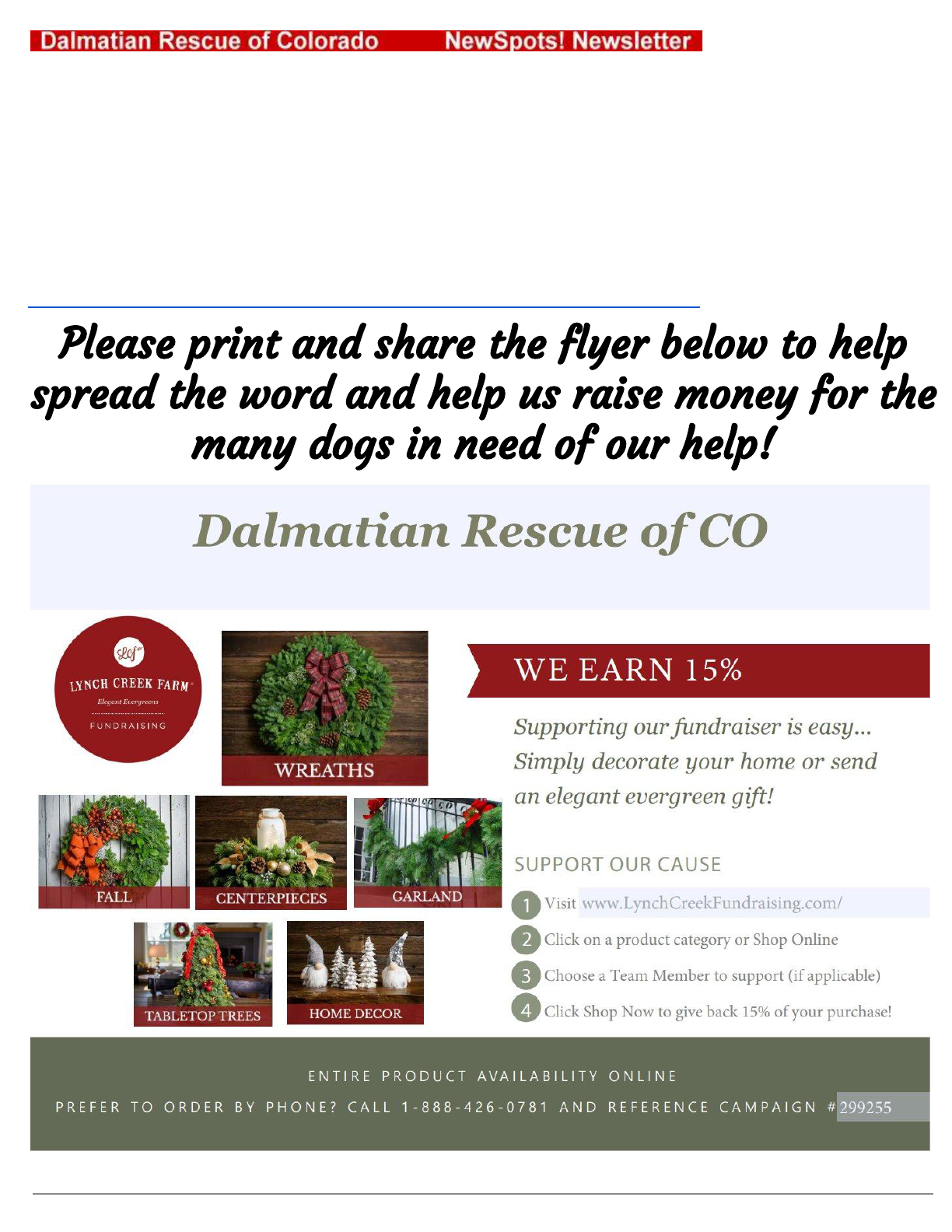
Sep 2, 2022 Page 5
Our Wreath Fundraiser has started!
Check out what is available! There are Fall and Thanksgiving options and then so many Christmas Options. We are going with
Lynch Creek Wreaths again this year.
Please note: They ship for free in the contiguous United States via UPS Ground. You select the approximate ship date for your
product. If you would like to pay for expedited shipping, that option is also available. They are not able to ship to Hawaii, Canada,
or PO Boxes.
Follow the link below. Our Campaign Code is 299255, so if you get to the website, you can find our page there.
Thank you for supporting DRC and we look forward to this Holiday Season!
https://www.lynchcreekfundraising.com/teams/299255-dalmatian-rescue-of-colorado-holiday-2022
Please print and share the flyer below to help
spread the word and help us raise money for the
many dogs in need of our help!

Sep 2, 2022 Page 6
Recent Adoptees!
Harlow2
Larkspur, CO
Lady
Spring Branch, TX
Mario
Denver, CO
Carley
Live Oak, TX
Attention Adopters!!!
If you haven’t already submitted your Happy Beginnings story, PLEASE, PLEASE, PLEASE take some time to do it now!
Yes, I am begging. We really would like to have your stories on the website and make you a star here in the NewSpots!!
What are you waiting for? Submit your stories and a new photograph of your fur kid(s), and yourself if you want, to me today!
September is Dog Tick Season (continued from page 4.)
Step 7: Once the tick is removed, wash the bite area with mild soap and warm water. Keep an eye on it over the next several days
for signs of irritation or infection. It should clear up in a few days—if not, see your veterinarian.
If you tear or bisect the tick during removal
It is vitally important to make sure the tick head is removed with the tick body to prevent additional infection and discomfort. If the
tick is crushed or bisected while you are removing it, you need to make sure you remove all of the bug's body from your pet's skin.
Take another deep breath and use the tweezers to draw out the head and legs.
Remember that you are not trained to do this, and if removing the tick starts to feel precarious, call your veterinarian for advice. He
or she will be able to tell you whether or not you need assistance. The same holds true for when your dog or cat has multiple ticks
on their body. Veterinarians are much better equipped to remove many ticks because they have advanced training and are set up to
perform the procedure in a sanitary environment. It can be quite common for a single dog to have in the upwards of twenty ticks if he
has been hiking on a particular trail during peak tick season in September and May. In those cases, you'll most definitely want your
veterinarian's help to keep your pet safe during and after the removal process.
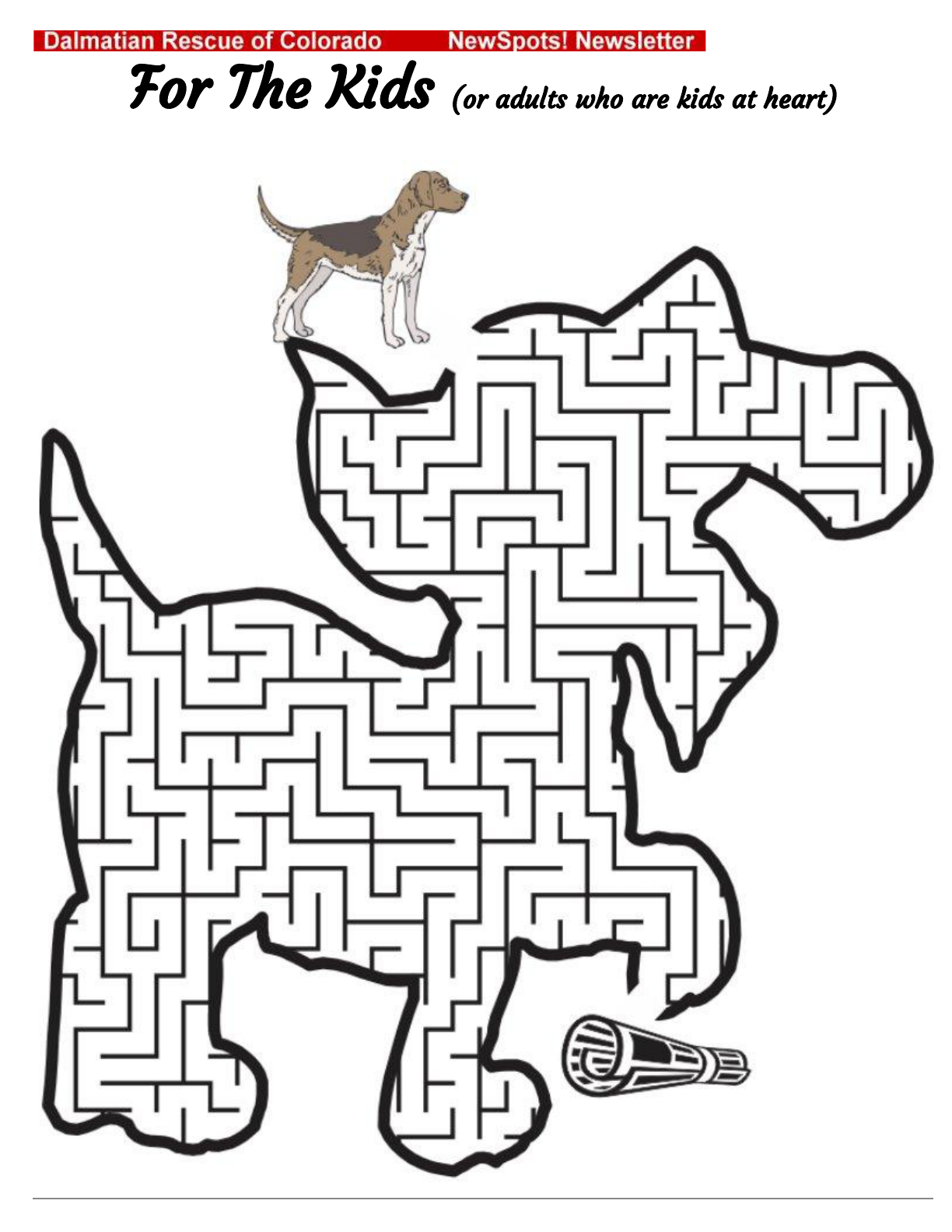
Sep 2, 2022 Page 7
For The Kids (or adults who are kids at heart)
Help the dog fetch the newspaper!
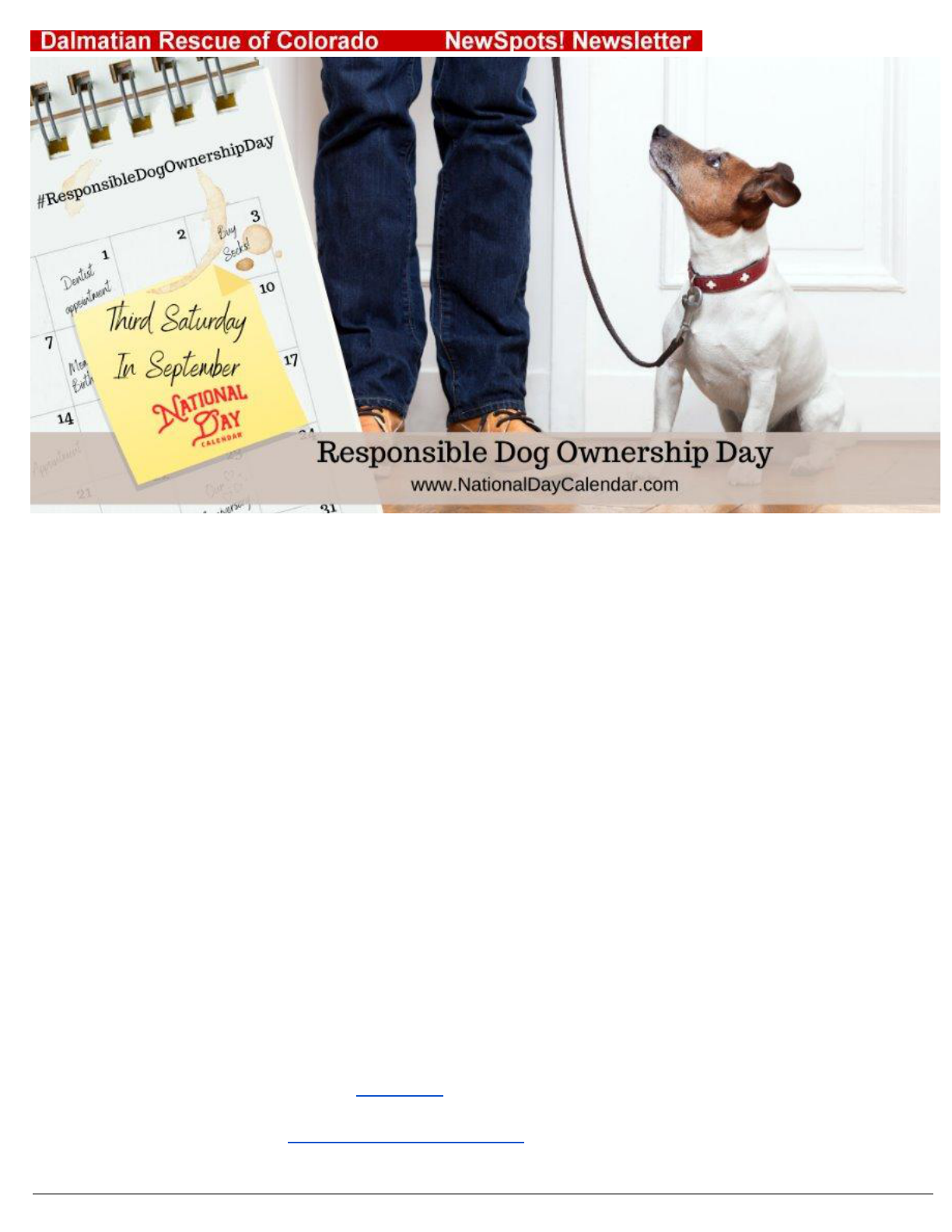
Sep 2, 2022 Page 8
RESPONSIBLE DOG OWNERSHIP DAY - Sep 17, 2022
On the third Saturday in September, Responsible Dog Ownership Day reminds pet owners to make a promise to your furever friend.
The observance encourages current and future pet owners to commit to being responsible for their loyal hound. Being responsible
protects not only the dog but all those who may be affected by him, too. Dogs bring many benefits to our lives. Ensuring they remain
healthy, happy, and safe is a vital part of our job as dog owners.
The pawsabilities for excellent pet care include:
● veterinary care
● training
● grooming
● exercise
● proper disposal of waste
● identifying household risks and dangers
● acceptable socialization
● registration according to local and state ordinances
We need to be on the lookout for their well-being and the well-being of those around them. It may come as a surprise to many how
much care dogs require. Keeping them healthy and safe includes many considerations. Their size, energy, medical care,
temperament, and many other needs are the dog owner’s responsibility. Often, dogs bring unexpected expenses. We need to be
prepared to make decisions regarding their care when illness or injury occurs, too.
HOW TO OBSERVE #ResponsibleDogOwnershipDay
Dog owners know how rewarding a canine companion can be. At the same time, a responsible dog owner knows they are
accountable for their dog’s behavior and health. Those rewards require effort and genuine commitment. Share your tips and
suggestions for those considering adding a dog to their family. Pose questions for others regarding how they maintain a canine
relationship. Give a shout out to your vet, groomer or another service for helping you to be a responsible dog owner. For more
information on responsible dog ownership, visit www.akc.org. Use #ResponsibleDogOwnershipDay to post on social media.
RESPONSIBLE DOG OWNERSHIP DAY HISTORY
The American Kennel Club promotes Responsible Dog Ownership Days across the country annually. Since at least September 17,
2003, (the 119th anniversary of the AKC), the observance has been encouraging dog owners to be the most respectful, caring, and
responsible companions to their canines they can be.
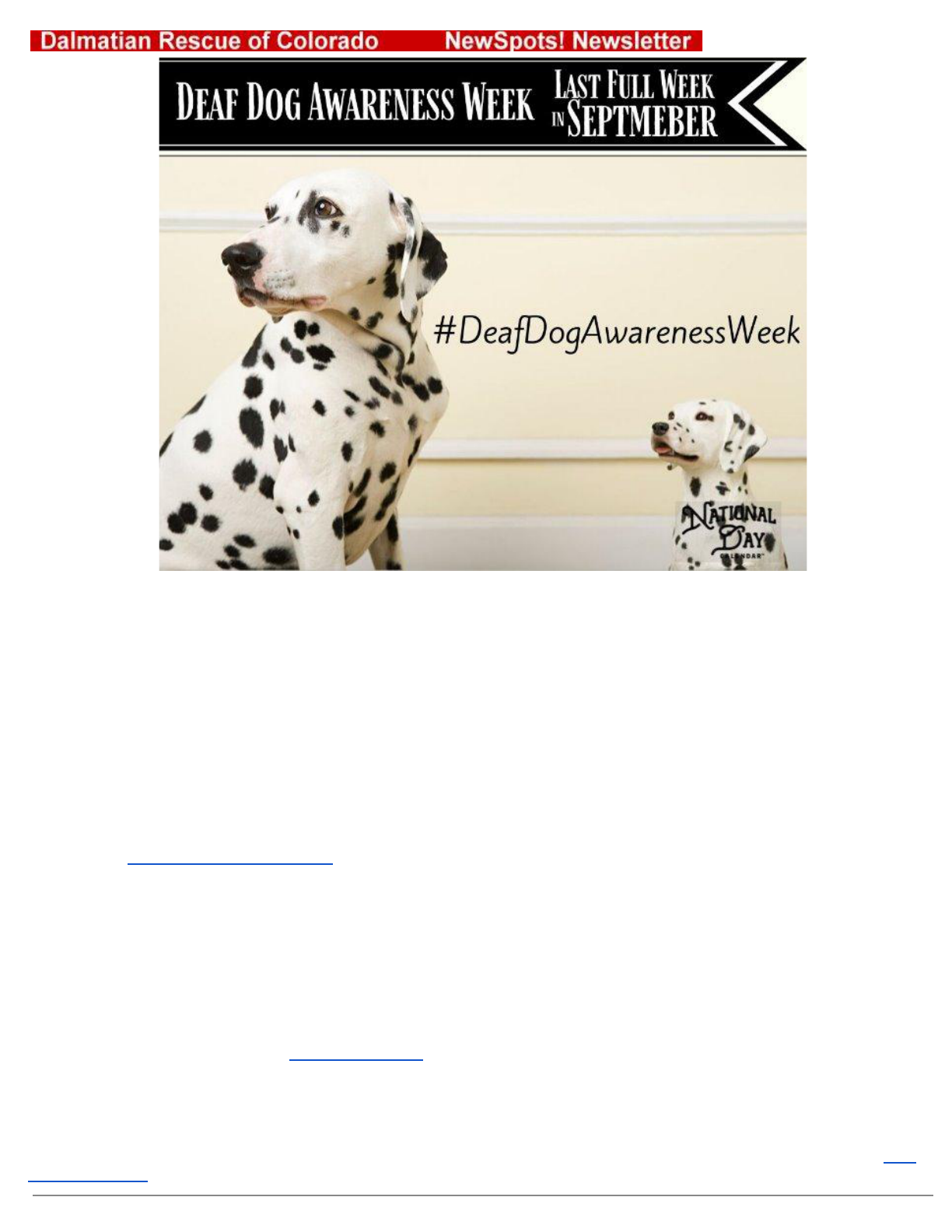
Sep 2, 2022 Page 9
DEAF DOG AWARENESS WEEK - Sep 18 - 24, 2022
Deaf Dog Awareness Week is the last full week of every September. It’s estimated there are about 35,000 dogs in the United States
who are deaf in both ears. Dogs who are deaf in just one ear are more common, about 120,000.
More than 30 breeds of dogs have a known susceptibility for deafness. Some of those breeds include Australian shepherd, Boston
terrier, cocker spaniel, Dalmatian, German shepherd, Jack Russell terrier, Maltese, toy and miniature poodle, and West Highland
white terrier.
In most of these dogs, the deafness is hereditary. And for nearly all, it is associated with piebald or merle coat patterns. (Merle is a
pattern in a dog’s coat. Merle comes in different colors and patterns. The merle gene creates mottled patches of color in a solid or
piebald coat, blue or odd-colored eyes, and can affect skin pigment as well.) So, almost any dog with white in its fur or any “blue”
dog is at least more likely to be deaf.
The Deaf Dog Education Fund says, “The most common cause of congenital deafness is pigment-related. If there is unpigmented
skin in the inner ear, the nerve endings atrophy and die off in the first few weeks of the puppy’s life, resulting in deafness.” Click here
to learn more: https://www.deafdogs.org/faq/
Training
Other than the loss of hearing, deaf dogs behave normally. They make all the regular sounds just like hearing dogs. Dogs who lose
their hearing or are born deaf, are also fully trainable, social, and eager to please. Trainers give commands using sign language. As
with hearing dogs, hand signals are an effective training tool.
Since they cannot hear cars or other dangers approaching, a deaf dog should never be allowed to roam freely outdoors. Owners
should provide a secure fenced enclosure instead. In some cases, electronic signaling devices are used to communicate with the
dog.
HOW TO OBSERVE #DeafDogAwarenessWeek
Learn more about deaf dogs from the Pet Health Network.
Learn more about rescuing a deaf dog.
Contribute to an organization that cares for deaf dogs.
Follow on social media. Use #DeafAwarenessDogWeek #NationalDeafPetWeek to join the conversation
DEAF DOG AWARENESS WEEK HISTORY
Why is Deaf Dog Awareness Week celebrated this week? It’s because this week is both National Dog Awareness Week and Deaf
Awareness Week.

Sep 2, 2022 Page 10
Help Us Raise Money While You Shop!!
What’s It All About?
AMAZON.SMILE
AmazonSmile is a simple and automatic way for you to support Dalmatian Rescue of Colorado, every time you shop, at no cost to
you. When you shop at smile.amazon.com, you’ll find the exact same low prices, vast selection and convenient shopping
experience as Amazon.com, with the added bonus that Amazon will donate a portion of the purchase price to Dalmatian Rescue of
Colorado.
To shop at AmazonSmile, simply go to smile.amazon.com from the web browser on your computer or mobile device and start your
shopping at AmazonSmile. You will see eligible products marked “Eligible for AmazonSmile donation” on their product detail pages.
Recurring Subscribe-and-Save purchases and subscription renewals are not currently eligible.
You use the same account on Amazon.com and AmazonSmile. Your shopping cart, Wish List, wedding or baby registry, and other
account settings are also the same. On your first visit to AmazonSmile (smile.amazon.com), you need to select the charitable
organization (Dalmatian Rescue) to receive donations from eligible purchases before you begin shopping. Amazon will remember
your selection, and then every eligible purchase you make at smile.amazon.com will result in a donation.
You can change your charity any time. Your AmazonSmile purchases after the change count towards your newly selected charity. To
change your charity, sign in to smile.amazon.com on your desktop or mobile phone browser and simply select “Change your
Charity” in “Your Account.” You can choose from over one million eligible 501(c)(3) public charitable organizations. Look for
Dalmatian Rescue of Colorado to make us your charity of choice!
KING SOOPERS/CITY MARKET COMMUNITY REWARDS
For Colorado supporters (or anywhere King Soopers or City Market operates), Dalmatian Rescue of Colorado has also enrolled in
the King Soopers and City Market Community Rewards Program.
To Use the King Soopers or City Market Community Rewards Program, simply visit the appropriate link below.
For King Soopers Stores - go to http://www.kingsoopers.com
For City Market Stores - go to http://www.citymarket.com
Once logged in to your King Soopers or City Market account, search for Dalmatian Rescue of Colorado, Inc., either by name or
FR415, and then click Enroll. New users will need to create an account which requires some basic information, a valid email
address and a loyalty card.
*Customers must have a registered King Soopers or City Market loyalty card account to link to our organization. If you do not yet
have a King Soopers or City Market loyalty card, they are available at the customer service desk at any King Soopers or City
Market.
REMEMBER, purchases will not count for our organization until after you have registered your loyalty card (the same card that you
use to build fuel points). You must swipe your registered King Soopers or City Market loyalty card or use the phone number that is
related to the registered King Soopers or City Market loyalty card when shopping for each purchase to count. This does not affect
your fuel points!
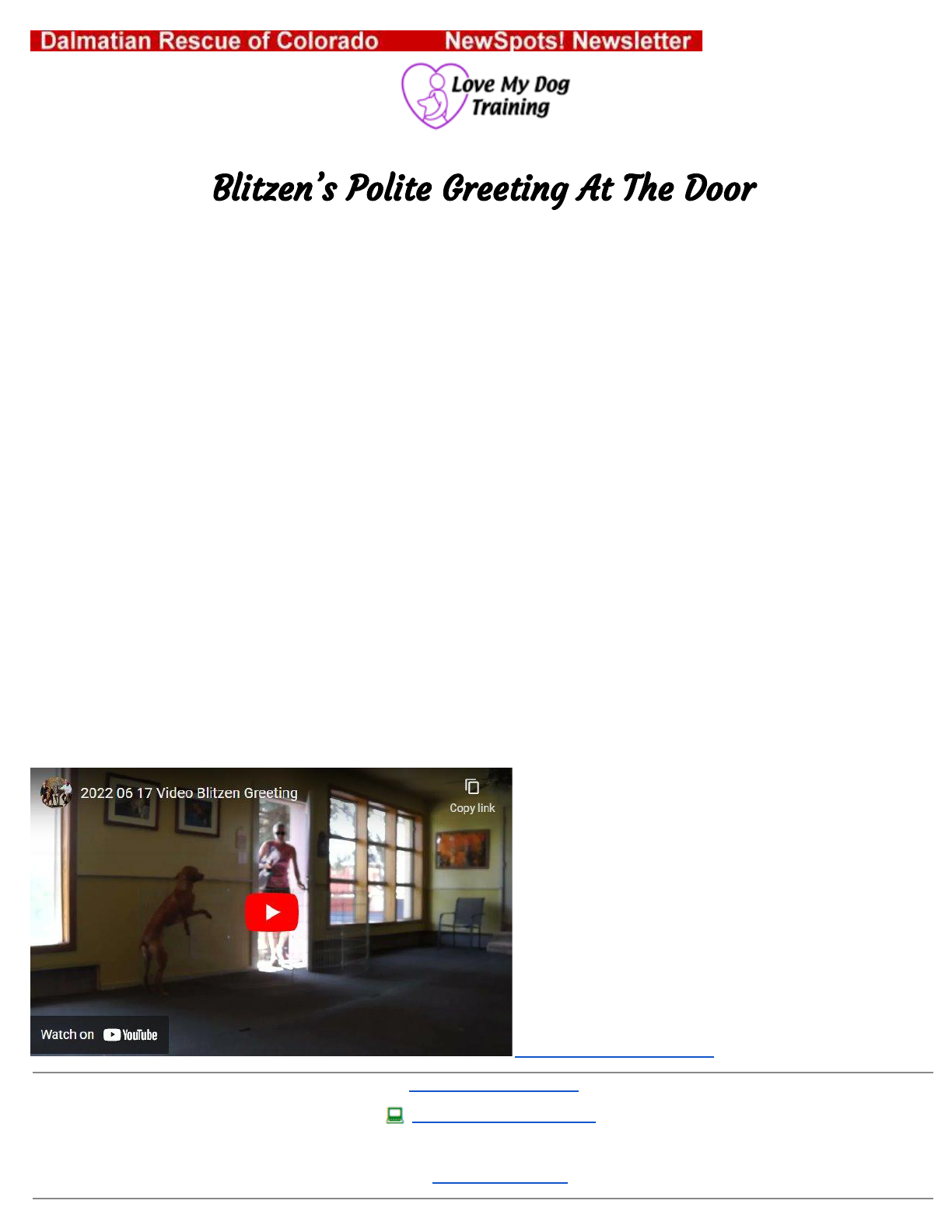
Sep 2, 2022 Page 11
Trainer Tips
“Blitzen’s Polite Greeting At The Door”
© 2004-2022 The Light of Dog
Does your dog greet you politely when you return home? Watch the video to see if Blitzen greets me politely. . .
We love how excited our dogs are when we return home. Who else in our lives is THAT excited for us to return home?
Greetings can be problematic though, if the greeting is out-of-control. Jumping, barking, nipping, and other perfectly natural dog
behaviors can become a huge problem if you are getting scratched up or even knocked over when you come in the door.
I want my dogs to be excited and happy to see me without being over-the-top out-of-control.
Blitzen does a nice job of that now. He's two years old in this video. He is not nearly as polite if we allow him to greet with Zooka at
the same time!
The video actually starts before I get to the door. Blitzen runs over to the window when he realizes that I am home. You see his tail
wag, but he's still pretty calm.
Then he sees me approaching and starts to bark a bit. This is still pretty calm for him.
Then he waits patiently for me to open the door.
You will also notice that we have an ex-pen set up around our front door. This is a safety measure for our boarding dogs so that no
one can easily slip out the door unexpectedly. Our dogs do not rush out the door, but we always keep it in place to make sure we
keep up good habits when boarding dogs are with us.
The ex-pen also allows me to get in the door without being bombarded if I do have dogs who do NOT greet politely. Or if there are
multiple dogs greeting me at the door. This gives all the dogs a chance to see me but calm down just a bit before they can actually
make physical contact with me.
When I enter, he is bouncy but can't get to me. He's just bouncing up and down. Perfectly acceptable behavior. He's excited but not
out of control.
Once I move the ex-pen, he greets nicely. All wiggles but all four feet on the floor.
Then he just can't help himself and does jump up. I remove attention and move on. He quickly gets all four paws back on the floor.
When he gets excited again, I direct him to go grab a toy. He often has already grabbed a toy by the time I come in.
We still have a little work to do to entirely eliminate the jumping, but it's not bad. He's more up and down, rather than all over me.
Overall, a much calmer greeting than we had last year.
How do your dogs greet when you come home?
https://youtu.be/KZXkfXLtA9I
For additional training tips and information, you can read our blog at https://thelightofdog.com/read/ or find us on Facebook and Twitter.
https://thelightofdog.com/
Copyright © The Light of Dog. All worldwide rights reserved
(This “Ask The Trainer” article is reprinted with permission of Sue Brown, co-owner of The Light Of Dog, a Certified Dog Behavior Consultant. The Light of Dog
Training is located in Sedalia, CO and services the Denver Metro Area. https://thelightofdog.com).

Sep 2, 2022 Page 12
Bits & Pieces
Advertising in NewSpots! is FREE!!!
Do you have a business or a hobby that other adopters, fosters, and volunteers might be interested in? Let us help you spread the
word by ‘advertising’ in Dalmatian Rescue of Colorado’s monthly newsletter – NewSpots! We currently notify about 1200 people of
the new editions of NewSpots! That’s a lot of word of mouth and print advertising for FREE!
Simply contact the editor, Karl Schill, at [email protected]
and he will work with you to provide your ad and place it prominently within the newsletter.
Foster Homes Needed!!
***** Be a Pal, Save a Dal *****
PLEASE – They need YOUR help!! Remember when your rescue Dalmatian came home with you, from the warmth of a loving
foster family? If we hadn’t had foster homes, you probably would not have gotten YOUR dog. PLEASE think about fostering a dog
for the Dalmatian Rescue where you obtained your Dal, or the one closest to where you now live, so they can save lives like they
saved your dog’s life!! PLEASE give a warm home to a dog who can relax, show his true personality, enjoy a thick bed rather than a
concrete floor in a shelter and get ready for a new home. PLEASE help rescues and the dogs so that others might have a dog that
is well socialized, trained and ready to love. PLEASE think about this… Dalmatians are everywhere and are literally dying to meet
you or someone willing to give them a “spot” to LIVE until their forever home comes along. PLEASE be a spot for rescue and for
them?
We thank you and you know any dog you help your local rescue save will be eternally grateful! PLEASE submit a foster application
if you can possibly help your local rescue and them! PLEASE take your cookie… good boy/girl!
Reader Recommendations and Tips
This is where we share recommendations and tips from and for our readers. Our newsletter is read by as many as 1800 people
each month. That number constantly increases as we have more adopters and adopters recommend it to their friends and family as
well. So, go ahead… share your tips and recommendations. Please send along any information you want to share with others, like
products that you would recommend, dog toys, great pet insurance, good vets (or bad ones to avoid as well), etc. Is there anything
you wish someone had told you about that you have found? Pass it along. Send your ideas, recommendations and tips to Karl at
[email protected] for inclusion in the next issue.
We NEED your participation to make the Reader
Recommendations and Tips segment a successful segment.
It is nice to be able to pass along information, tips and
suggestions that you have found useful or helpful so that
others can benefit as well, but without your participation
it doesn’t work! So please submit your ideas!!
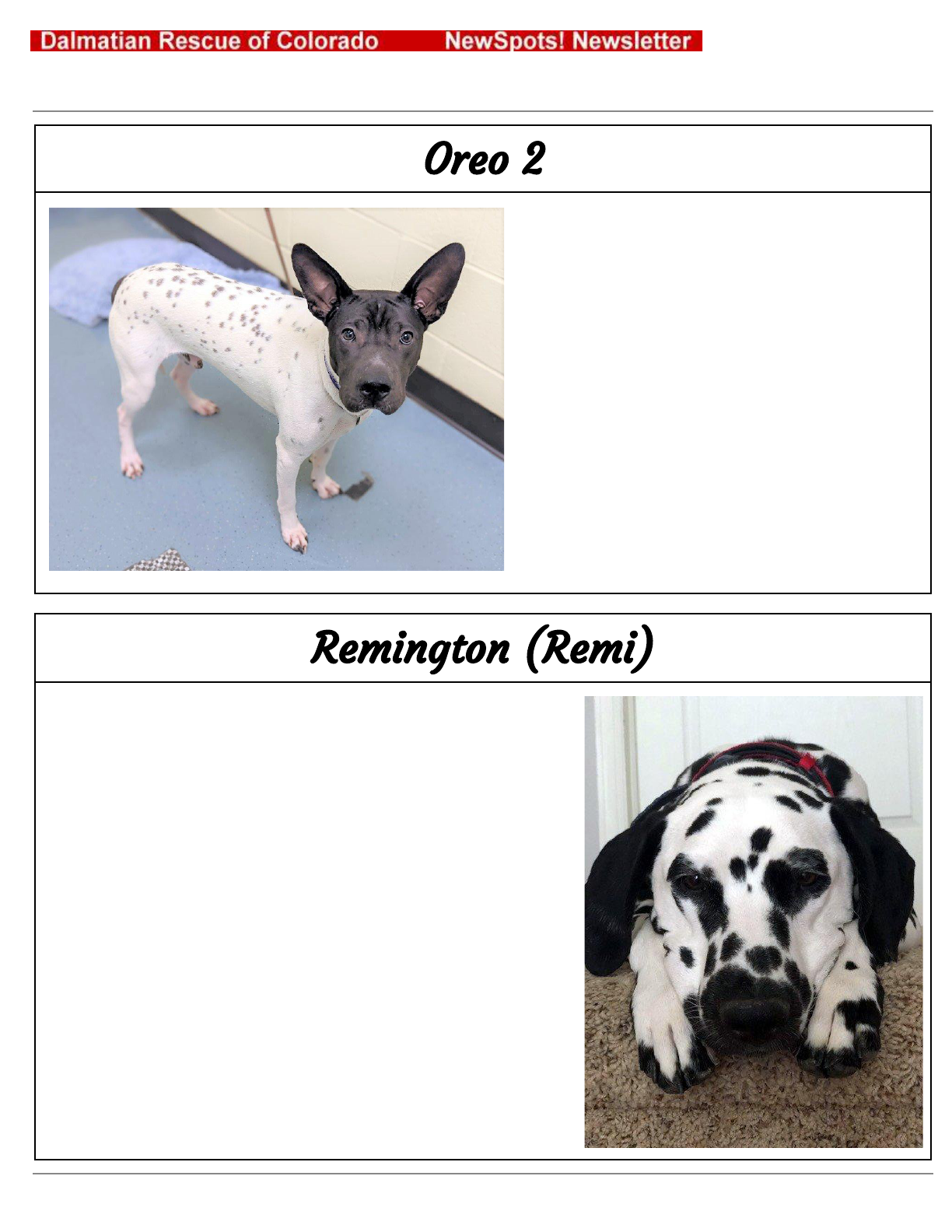
Sep 2, 2022 Page 13
In The “Spot”Light… Our Featured Dalmatians
Oreo 2
1 Year Old, Black, Neutered Male
Reason Available: Owner Surrender
Foster Home: Aurora, CO
Oreo is a cute, young male, just 38 pounds, who is
learning to trust people again. When first pulled from the
shelter, he was extremely scared and defensive. Within a
couple of days, he's become a friendly, playful boy. He is
still timid about meeting new people, but with more love
and training, he will become an excellent companion. He
is housebroken and signals when he needs to go outside.
He'll need leash training along with basic obedience, but
he is very smart and treat motivated, so training should go
smoothly. After only 3 days in his foster home, he is
responding to his name and learning to sit, stay and
come. He's an unusual looking fellow with a huge heart
who just wants to play and to love. Donation for this cutie
more information.
Remington (Remi)
3 Year Old, Black, Neutered Male
Reason Available: Owner Moving
Foster Home: Aurora, CO
Remington (Remi) is a beautiful black and white purebred Dalmatian male
who, at three years of age, is losing his home due to separation and divorce.
Remi is a great family dog who loves giving kisses, playing with his toys, and
going for walks. Although he knows some commands, obedience classes
would be very beneficial to Remi and his new family. He can open some
doors and operate the ice dispenser on the refrigerator. He loves to eat (as
can be seen by his slightly round appearance). Remi is a fun, active dog
who would love a large yard and one or two animal companions. He can be
a little protective of his family members, so we recommend that children be
older than 10. For more information, contact
[email protected]. Remi's adoption donation is set at $400.
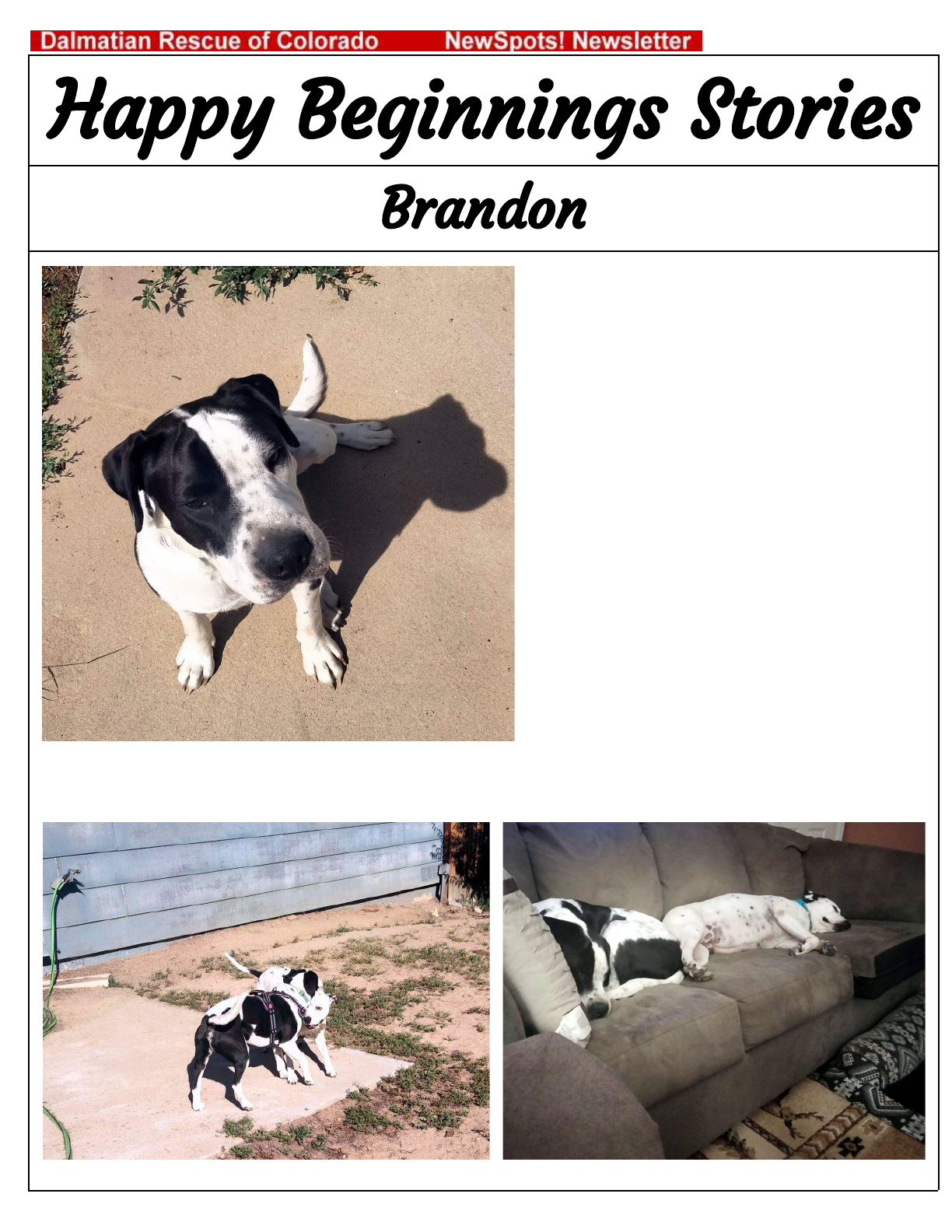
Sep 2, 2022 Page 14
Happy Beginnings Stories
Brandon
After my last dog, Mojo, passed away I was looking for
another dog. It took a long time to find just the right fit and
personality. After working with Dalmatian Rescue of
Colorado, I finally found the perfect dog in Brandon.
Initially I was not sure if he would fit into the household,
but when we first met him, he took to Breton, my brother’s
dog, quickly. The trip home was so easy, and he didn’t
have any problems on the long trip from Ohio to Colorado
Springs, Colorado. They cuddled together for most of the
drive. He gets along very well with Breton, and they play
together all day long in the back yard and inside the
house, too!
He knows commands like ‘sit’ and how to say ‘hi’ and is
learning ‘stay’ and will start obedience training in a couple
of weeks.
Brandon is an incredibly happy dog and loves to greet us
at the door when we have been gone. He is such a joy to
have and helps get me out of the house for walks around
the neighborhood.
I would like to thank Tena and Jessica for their roles in
saving this wonderful boy and allowing him to join the
family.
Dudley S.
Colorado Springs, CO
Playtime in the back yard! All that play makes for a couple tired doggos!
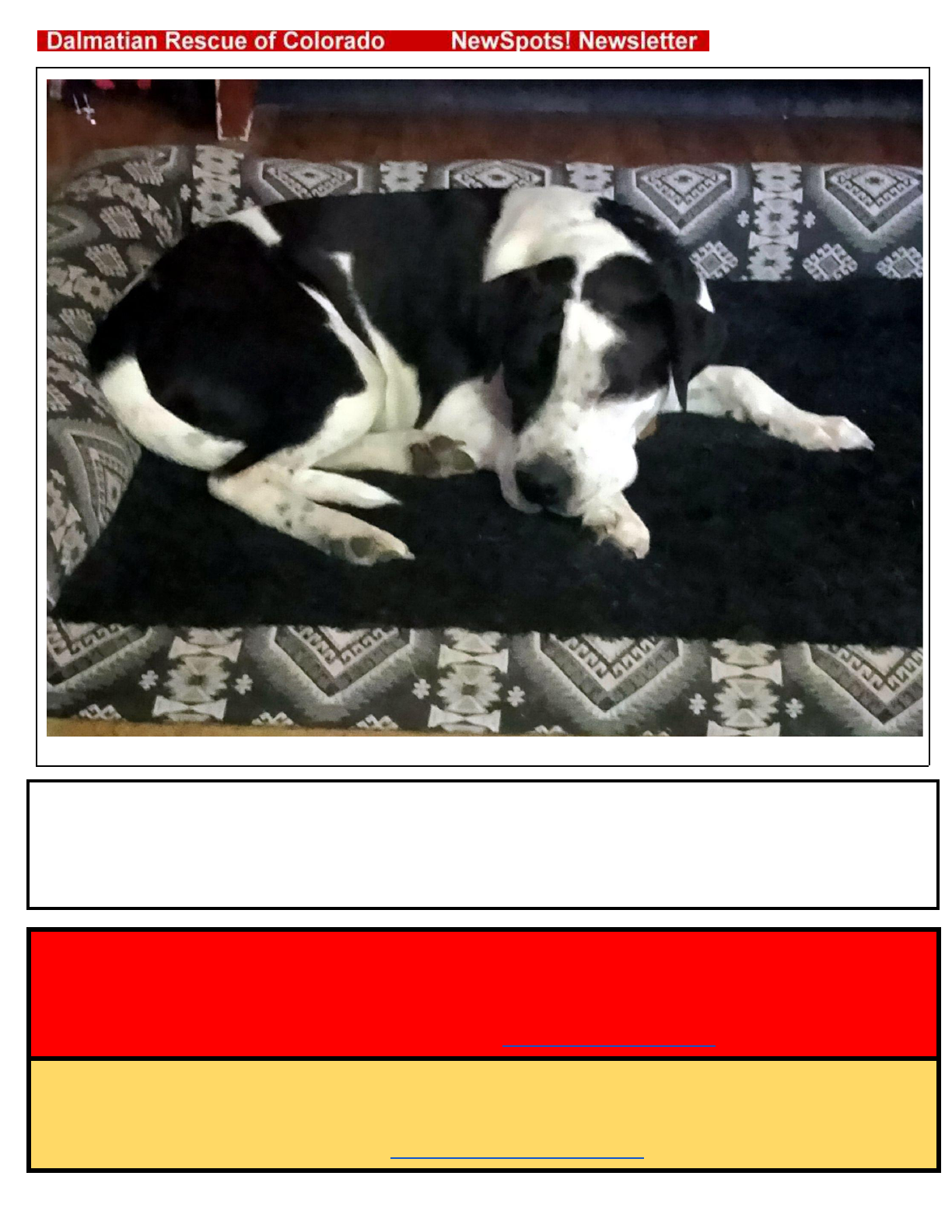
Sep 2, 2022 Page 15
Naptime! ZZZZZZZZZZZZZZZZzzzzzzzzzzzzzzzzzzzzz
It’s never too late to see your story in print!
If you have adopted your pup from us, regardless of when, and have not submitted their Happy Beginnings story yet,
please do it now while it’s fresh on your mind.
These stories are the “pay” that fosters get for all their hard work!
About Us
NewSpots is published and released on the first calendar day of the month. The deadline for submissions for future issues of
NewSpots is the 25
th
of the previous month. Submissions received after the deadline may be delayed in publication until the
following month, subject to the Editor’s discretion.
Send submissions to the Editor at [email protected].
Dalmatian Rescue of Colorado, Inc. is a 501(c)(3) Non-profit organization. Donations are tax deductible!
3428 CR 27, Loveland, CO 80538
Rescue Hotline: 303-281-8963
Website: http://www.dalmatianrescueco.org
